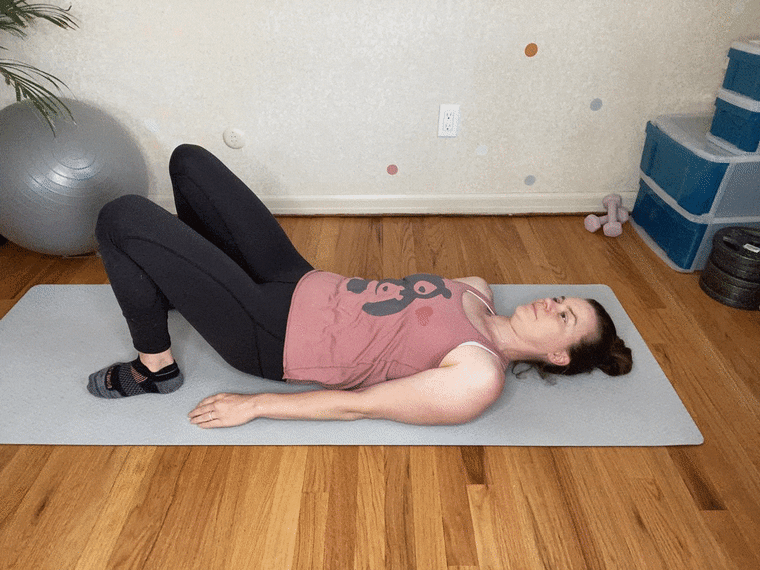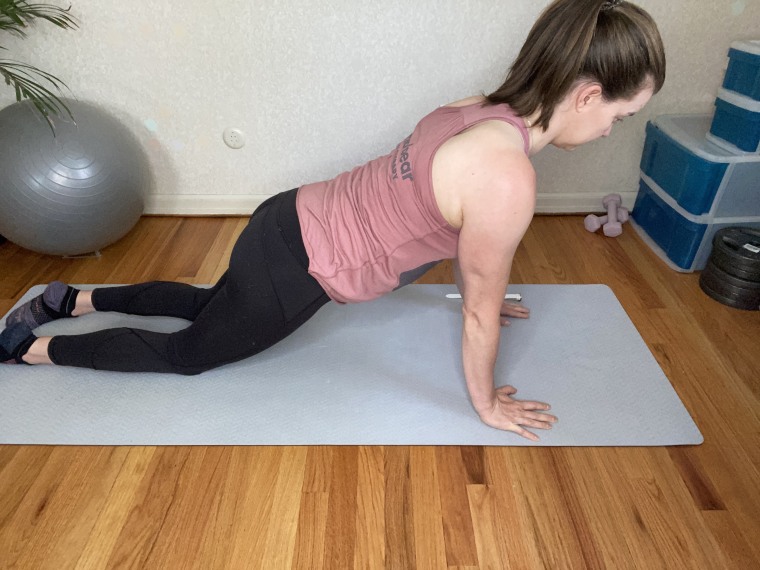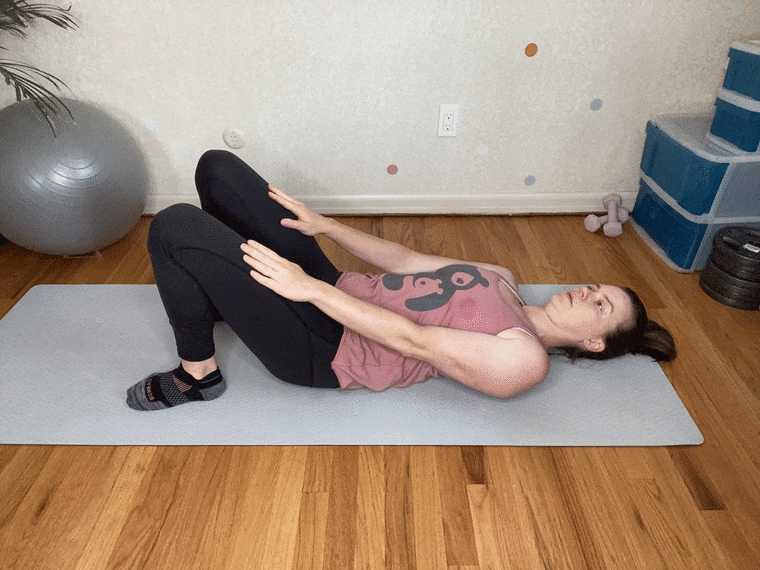A popped belly button and stretch marks aren’t the only changes your midsection goes through with a growing bump. After giving birth, you might have noticed that there’s a gap between the left and right sides of your ab muscles.
During pregnancy, your uterus expands to accommodate your baby. This increases the outward pressure on the abdominal wall and causes the muscles to stretch and weaken, especially the linea alba — the connective tissue between the two halves of the rectus abdominis (the superficial ab muscle in the front of your belly).
As the linea alba stretches under the pressure, your abs may separate, causing what is known as diastasis recti, explained Helene Darmanin, an orthopedic and pelvic health physical therapist and founder of Mama Bear PT. Ab separation is normal with pregnancy, but with diastasis recti, the gap is more significant and doesn’t resolve on its own within a couple of months of giving birth.
“The most current thinking is that most pregnant folks have abdominal separation by the time that they give birth. About two-thirds of folks will have a spontaneous resolution of the separation within the first few weeks of postpartum while others will not,” Darmanin said.
In fact, a June 2016 study of 300 first-time pregnant women published in the British Journal of Sports Medicine showed that 33% percent of the women developed diastasis recti during week 21 of pregnancy and 60 percent developed it six weeks postpartum.
How can I tell if I have diastasis recti?
Diastasis recti might seem concerning, but Darmanin said that ab separation itself isn’t an issue. “It all depends on how functional the abs are regardless of separation,” she said. “So it is only a problem if you are having symptoms, such as back, hip or abdominal pain.”
Not sure if you have diastasis recti? In addition to the symptoms above, Darmanin said you may also notice coning or doming of your belly when you do activities that involve your ab muscles. Another way you can tell if you have the condition is if you’re able to sink a couple of fingers into the soft space between the two halves of your rectus abdominis when performing a crunch.
How to treat diastasis recti with exercise
It’s important to get a proper diagnosis, so it’s best to see a physical therapist if you’re experiencing symptoms or suspect you have diastasis recti. That said, you can improve the ab separation by focusing on strengthening your entire core, especially the rectus abdominis and the transverse abdominis — the deep ab muscle, Darmanin said.
“Instability in the hips and tension in the upper back can also make diastasis recti worse, so those issues should be addressed,” she explained.
As for what types of ab exercises you should be doing versus those to avoid, Darmanin said it depends on a variety of individual factors, all of which should be assessed by a physical therapist. But one thing that all women with diastasis recti should focus on during exercise is proper breathing technique.
“No breath holding or Valsalvas (exhaling against a closed glottis as weightlifters do when they lift heavy) because they can increase the outward pressure from the abdomen, which can make diastasis recti worse. Instead, they should do a full, slow exhale during the effortful part of the exercise," Darmanin said.
4 exercises that help repair diastastis recti
With these tips in mind, here are Darmanin’s go-to exercises to help improve diastasis recti. By doing these strength exercises 3 to 4 times a week, Darmanin said you should start to see improvements in the gap between the ab muscles and pain symptoms within 6 to 8 weeks. But if you’re not seeing any progress after 4 weeks, consult a licensed physical therapist who has experience in healing diastasis.
Glute bridge
Bridges are not only great for contracting the rectus abdominis, but it also strengthens the low back, glutes and hamstrings. These muscles are key for carrying out everyday activities, such as picking up your child and lifting heavy groceries.
“Make sure to keep the inner thighs parallel, exhale on the ascent, and imagine someone put a sandbag on your breastbone to get the maximum benefit,” Darmanin said.

How to: Lie face-up on the ground with your knees bent and your feet hip-width apart. Place your heels about a foot away from your butt and keep your arms by your sides. On an exhale, drive through your heels to lift your hips and low back off the ground, squeezing your glutes at the top. You should create a diagonal line from the top of your knees to your shoulders. Avoid overextending the low back, which can cause strain. Complete 2 sets of 10 reps.
Plank
This full-body move gets all of your core muscles fired up and working together, Darmanin said. To ease back into doing planks and decrease their intensity, Darmanin suggested doing them on your knees. Just remember to keep your shoulders directly over your wrists.
“Make sure you can take deep breaths and that the stomach is hugging gently up toward the spine. Stop if you notice a tenting shape, aka coning, to the belly,” she said. Instead, you can regress to a plank on the knees or an incline plank on a wall and then a counter. The goal is to gradually decrease the incline until you can do a plank on the floor without coning or doming.

How to: Kneel on the ground and stack your shoulders over your wrists, resting your shins flat on the floor. Tuck your pelvis in to engage your core and tighten your glutes and quads. If you feel comfortable leveling up to a high plank, extend your legs straight behind you and tuck your toes, forming a straight line from the top of your head to your heels. Hold for 15 seconds for 2 sets, eventually working your way up to 30 seconds.
Dynamic lunge stretch
During pregnancy, the rectus femoris — the longest quad muscle, which is also a hip flexor — shortens due to your growing bump. In this shortened position, it pulls on the front of the pelvis, creating stress on the ab muscles, Darmanin explained. This lunge variation lengthens the rectus femoris and helps take the pressure off those ab muscles.

How to: Start in a high lunge with your front leg bent and your back leg straight behind you. Make sure the back leg is far enough behind you so that your heel is off the ground. Keeping your back and chest tall, bend the back leg without moving your front leg. Then straighten the back leg. Complete 1 set of 10 reps.
Crunches
Crunches might be the last thing you thought you should be doing with diastasis recti, but Darmanin said that because it solely targets the rectus abdominis, it helps strengthen the muscle and repairs ab separation. As with planks, you should avoid this exercise if you see tenting of the belly; stick with the other exercises on this list as you work your way up to doing crunches.
“I know this is a very contentious choice, but the most recent research shows that creating hypertrophy (increasing muscle size) of the rectus abdominis can be very helpful for improving diastasis recti,” Darmanin said. “Therefore, an exercise focused on that muscle can be really beneficial if done well.”

How to: Lie face-up on the ground with your knees bent and feet flat. Place your hands on your thighs. On an exhale, lift your head and shoulders off the ground as you slide your hands up your thighs. Imagine your belly gently hugging your spine. Bring your head and shoulders back down to the ground and repeat. Complete 2 sets of 5 reps, working your way up to 10 reps.




